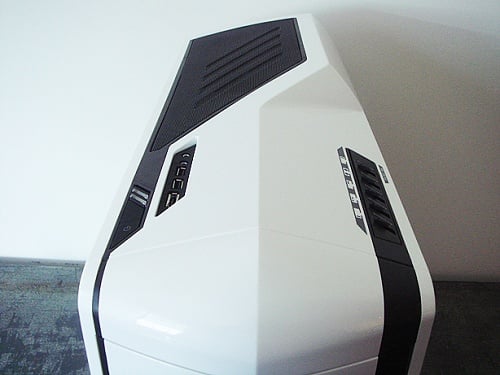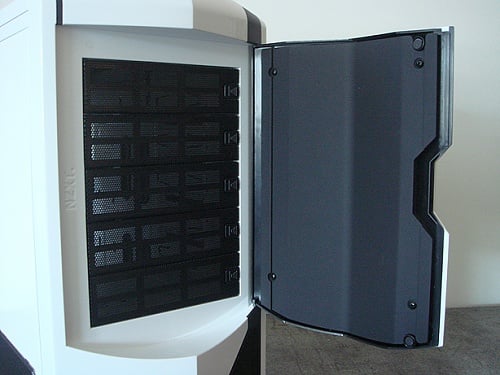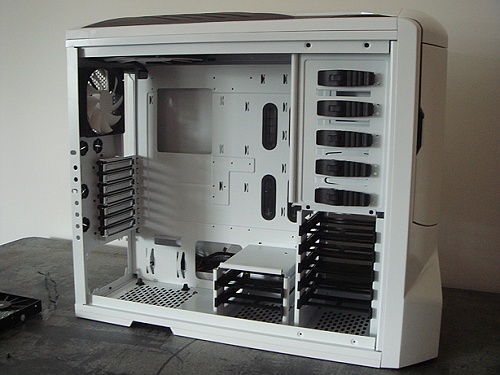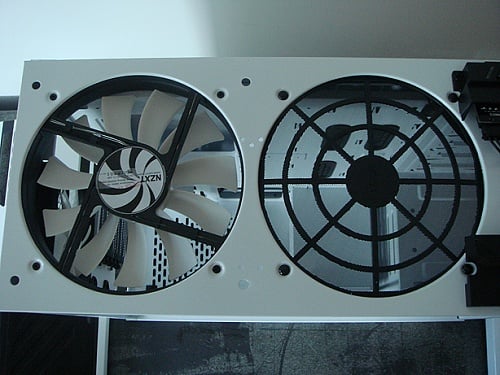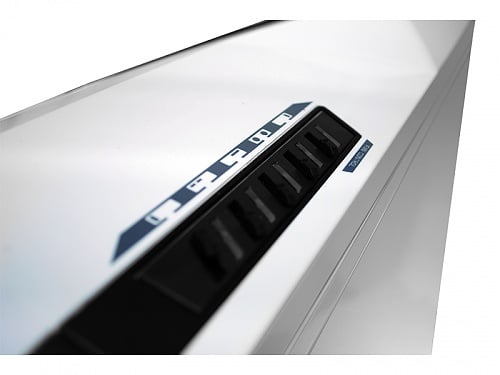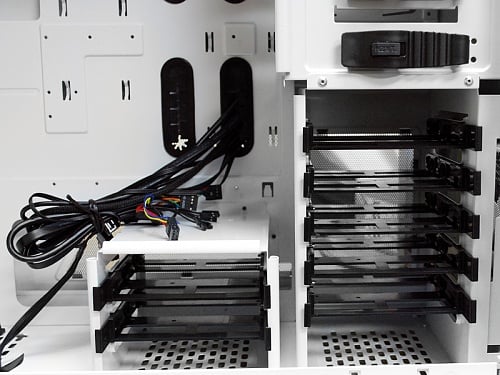The Phantom is the latest "crafted series" case from NZXT and it has a stylized, futuristic design that is the result of a collaboration with the renowned case modder, Craig Bruger (craigbru). It isn’t all about looks though. NZXT included a generous fan setup and otherwise tailored the trimmings with enthusiasts in mind. The Phantom isn’t perfect, but it’s a solid product that could boost NZXT’s reputation in the community.Packaging/Contents The Phantom ships in a practical fashion, cradled by two dense foam blocks. The cases finish is protected by a plastic film enclosing the entire case, with an additional layer on the top and front panels.
The manual rested inside one of the hard drive bays and the box of accessories was strapped into the 5.25 inch bay with a twist tie. There is a well-cataloged collection of screws suited for a variety of tasks, the majority of which are black anodized steel. A case speaker and a collection of plastic ties are also included. The reverse side of the case instructions contains a breakdown of the different types of hardware found in the box.
Appearance/Exterior
The majority of the chassis is constructed with steel, the exception being the front and top panels, which are molded from ABS plastic. Plastic is notoriously inferior as a case material. Small pieces tend to snap off and it is tragically excellent at retaining heat. NZXT wisely used it sparingly when designing the Phantom and luckily ABS is a particularly durable variation of plastic.
I usually look for aluminum when purchasing a computer case, but steel is an acceptable alternative. Painted steel cases tend to dissipate heat slower than an aluminum case, but it is a marginal difference with the Phantom’s efficient fan configuration. The steel does weigh the Phantom down quite a bit though, clocking in at 23.5 lbs.
The 5.25 in. bay covers are plastic vents with a quick release tab that adds a nice touch to the cover. The 5.25 in. bay was a little too wide for my disc drive, leaving about an eighth of an inch exposed around the top faceplate, and a 1/6 in. on any additional drives. When everything on the case is vented or sealed, this vulnerability is disappointing. It is forgivable only due to the fact that the 5.25 bay lies behind the door, which will usually be shut.
The door is one of the best I’ve seen on a case. It has a weight that imbues a sturdy feeling and NZXT employed magnetized bumpers that confidently hold the door in place when shut. It also opens 135 degrees, ensuring drive access from either side of the computer.
The two large panels on the side of the case don’t so much slide into place as they lock in. NZXT cleverly included spring-loaded screws that hold the door , even when the screw is loosened. Sliding the screw down frees the panel in a pleasantly controlled manner. This is a small, but defining feature that should be adopted by other manufacturers. Functionality/Interior The inside of the case is roomy and configured with organization in mind. There are grommitted slots to accommodate water-cooling connections and cable management. The power supply sits on rubber steps surrounding an air vent in the bottom of the case. NZXT did their best to make the Phantom an easy to use case. The only tool you will need is a Phillips head screwdriver to mount the motherboard, which was quite easy given the huge amount of space inside the Phantom. Even so, it is a shame that there isn’t a removable motherboard tray. It’s one of those features that can put the case over the top of the competition. The Phantom doesn’t necessarily need it, and I’m sure it was a cost cutting measure on NZXT’s part.
The inside has been painted in the primary case color, white, black, or red. When reviewing the white model, I found the blue LEDs attractive against the white and black, rather than extraneous. The fan controller and power/hd indicators glow when connected, but the 200mm fan on top can toggle its LED on or off. There is a handy push-button in the top corner of the back.
Plastic is used for the smaller parts of the case, including hard drive mounting brackets, buttons, the fan controller, and 5.25 inch covers. The hard drive brackets employ a rubber dampened and screwless drive mounting solution that is effective but just misses the mark in terms of construction. The metal pins that hold a 3.5 in. drive in place are encased in a rubber sheath that reduces vibration and noise from a spinning hard drive. The only problem is that the pins can slip out of their rubber sheath, permanently lying on the outside of the bracket. There is a potential to misplace one or two while squeezing a drive into the bracket, but it is only a minor flaw in hindsight and doesn’t affect the performance of the bracket.
2.5 in. drives can be mounted on the brackets as well, which requires traditional screws.
I also noticed that the smaller of the two drive bays has a minor flaw in the upper drive slot. For some reason, the bracket is less than snug in that particular bay. None of the other mounts or brackets suffer from this problem. Drives are inserted with the connection facing the back of the motherboard tray to accommodate cable management.
The back of the motherboard tray is recessed roughly an inch from the side panel and provides adequate room for snaking cables. It is important to take advantage of the plastic ties and the mounting points on the side of the case, bulging cables could potentially warp the side panel if it is forced shut.
The 5.25 in bays feature a rubber latch that holds DVD drives in place, but only on one side. I had to install screws on the opposite side to get a firm grip on the drive.
The case can hold a total of 7 fans, including three 200m fans, two up top and one on the side panel, which also has the option of holding a 230 mm fan. There are three slots for 120mm fans (two on the side, one on the back) and a 140mm mount up front. The Phantom includes 1x 200mm fan, 3x 120mm fans, a 140mm, and a 200 mm fan up top. It is a excellent setup that moves a lot of air and keeps the case quite cool. The 200mm fan mounts come with filters, but not for each one. Every panel is vented and shouldn’t require a filter however, and the provided filters might just serve to block the empty space when optional fans aren’t installed. An additional filter wouldn’t hurt though. Performance/Setup Assembling parts inside the case was simple and there was ample room to move about, securing cables and mounting components. It was easy to hide cabling for an organized setup. More than just look good, less clutter obviously equates to better airflow. The fans kept my idle temps around 30 degrees Celsius with the fans on the highest settings, and 34 degrees on the lowest. They are barely audible from a foot away at full speed, even with the heavily vented case. Quiet and breezy is the best way to describe the Phantom.
The top-mounted fan controller operates at 20w per channel and indicates connected fans with a blue led, which is either on or off, it doesn’t indicate the intensity of the particular channel. Sliders are acceptable, but knobs are considered somewhat standard, and are less prone to damage. The Phantom’s sliders feel sturdy, but moving parts are always at risk.
The two external USB ports, the E-SATA port, and audio jacks feel right at home on the top of the case. My only wish was that they were given a die-cut faceplate. As it is, you can recognize that they are a part installed in the case, rather than incorporated into the design. Value The Phantom has a retail price of $139, which feels just right for this case. NZXT slightly compromised on materials, but the tradeoff was a killer fan setup and little touches that are usually neglected in a lot of cases. The design is another factor when determining cost and I have to say that it is a composed product that fits a very particular aesthetic. It’s the kind of design you would expect when manufacturer meets modder.
The Phantom could be the best value on the market if it was priced at $99, but as it is, it is still a great deal and worth every penny. The plastic parts don’t really detract from the overall value or performance, either.
Summary The Phantom is a great case overall, sporting a striking design and thoughtful features that should please demanding computer enthusiasts. It would have been nice to see some aluminum in the case, but the steel and plastic that are used work well and lend the case a sturdy, albeit heavy, quality. For performance, value, and design, I can easily recommend the Phantom to anyone looking for an awesome tower that won’t break the bank. It is available in limited quantities now at NewEgg.com for $139, and should be available everywhere in early September.
